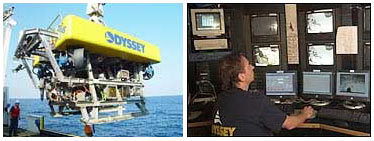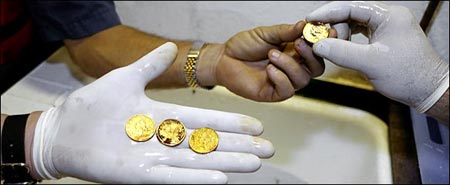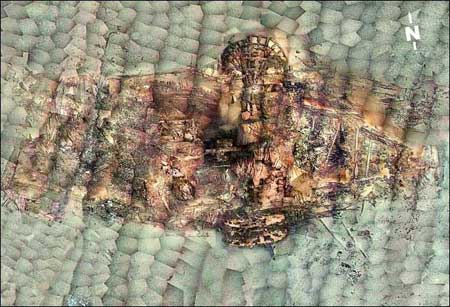JACKSONVILLE, Fla., Nov. 12 -(New
York Times)- When the 250-foot Odyssey Explorer docked here this
week to unload a trove of gold coins and valuable artifacts from
the wreck of the Republic, a 19th-century steamer, the Explorer's
deck was a blur of activity, bristling with the modern technology
now necessary for the recovery of sunken treasure.

Gerhard Seiffert, above, right, uses video
monitors on the Odyssey Explorer to map the location of shipwreck
sites. Above, left, an underwater research vehicle is used on
dives to the Republic.
A seven-ton submersible robot held pride of place. Its flexible
arm was equipped with tiny suction cups made of soft flexible
plastic for carefully picking up rare coins that can fetch up
to half a million dollars each. The robot is one example of the
sophistication and technological precision of this salvage effort,
which leaders say surpasses any previous shipwreck salvage.
Among the treasures brought to land this trip were coins, ceramic
pots, 600 glass bottles and some samples of technology from another
time - a telescope and the ship's barometer, which probably fell
rapidly as the storm grew in strength.

The recovery has not always been smooth. When the robot gingerly
picked up its first gold coin, it fumbled, dropping it back onto
the seabed instead of into the impromptu holding tank, an old
chamber pot.
One year and more than 52,000 coins later, the team has set new
records in deep recovery. From the disintegrating hulk of the
sidewheel steamer that sank in 1865 about 100 miles off Georgia
while battling a hurricane, the robot has plucked gold and silver
coins valued at more than $75 million. And it is pursuing billions
more in lost treasure.
"We've gotten really good at picking up coins," said
Greg Stemm, director of operations for Odyssey Marine Exploration
Inc. of Tampa, Fla.
The Republic lies a third of a mile down in the strong currents
of the Gulf Stream. The main wreckage lies scattered over an area
nearly the size of a football field, making its discovery and
recovery a challenge.
Finding it took special sonar. Photographing it for archaeological
surveys and artifact collection took powerful lights and cameras.
Mapping the position of each artifact took precision gear linked
to a network of sonic beacons set up around the wreck. And lifting
52,000 coins and 12,000 artifacts - the haul so far - took the
precise control of a tethered robot nearly the size of a tank,
its arms dexterous enough to thread a needle.

More than 4,600 digital still photographs
of the Republic's wreckage were turned into a detailed photo mosaic.
The main wreckage lies scattered over an area nearly the size
of a football field.
"It's all about computers and digital technology,"
Mr. Stemm said. "It adds a whole lot of archaeological capability
to the operation."
"We're doing it to an extreme that nobody else has taken
it to," said Tom Dettweiler, the project's manager and a
deep-sea veteran who helped discover the Titanic's resting place.
Clad in dark blue overalls, James Andrade, a supervisor of robot
operations with a weight lifter's build, showed off a high-tech
control room crammed with panels and video monitors. At sea, the
recovery work can go around the clock, day and night, tedious
despite the high stakes.
"Most important," he said, "we have satellite
radio and an espresso machine."
The Republic sailed from New York on Oct. 18, 1865, bound for
New Orleans with families, businessmen and a diverse cargo of
trade goods meant to help the shattered South recover from the
Civil War, its passengers brimming with optimism and a sense of
opportunity.
The storm hit off Georgia. For two days, the steamship fought
wind and wave. Then the engine failed. The crew and passengers
threw cargo overboard to lighten the ship. But the pumps failed
and seawater poured in.
Most people made it into lifeboats and a raft. Of 59 passengers
and crew, 42 survived. But the cargo of money - $400,000 in coins,
as described in newspapers of the day, including The New York
Times - went down with the ship.
Mr. Stemm and his partner, John C. Morris, began looking for
the Republic in the early 1990's. Nothing came of the periodic
hunt until July 2003, when, some 100 miles southeast of Savannah,
they picked up a tantalizing image on sonar screen. Within a month,
the team had positively identified the decomposing wreck by retrieving
the ship's bell.
Experts estimated the current value of its lost coins at up to
$150 million. Odyssey, a public company, hopes to make a profit
mainly by selling coins and setting up shipwreck museums and exhibits.
Late last year, team members flew the tethered robot about 15
feet above the wreckage, taking more than 4,600 digital still
photographs and turning them into a detailed photo mosaic.
"We can zoom in on domino stones and see the dots,"
Gerhard Seiffert, the team's data manager, said as he demonstrated
the technique at a computer, zooming in on an old domino made
of wood and ivory. |

